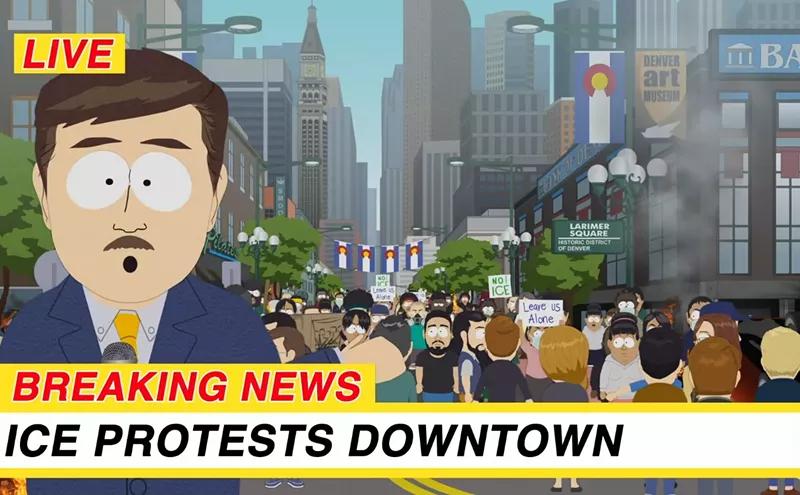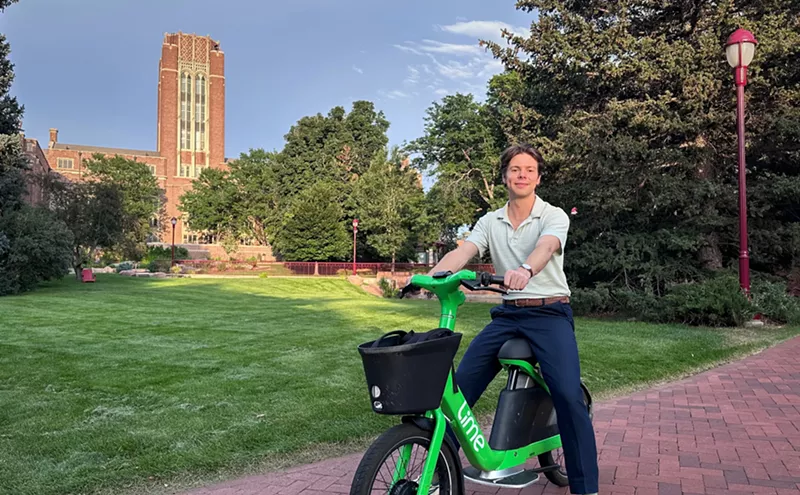In 1991 Eli was diagnosed with carpal tunnel syndrome in both her hands. Carpal tunnel is a nerve disorder that often affects people who work intensively with their hands, sometimes causing extreme pain. She had surgery on both hands and soon returned to work. "I had my stitches out after ten days and was back to work the next day," Eli recalls. Things were fine until about a year and a half later, when she noticed the familiar pain in her hands again and the pain started moving up her arms toward her shoulder. She sought further medical treatment and says she soon discovered that, in Colorado, injured employees are presumed guilty until proven innocent.
Under current Colorado law, all people injured in the workplace are referred to a doctor hired by their company or their company's insurance carrier. Eli saw a doctor contracted by King Soopers, which is self-insured, to handle workers' compensation cases among its employees. Despite her pain, the doctors provided by her employer kept telling her it was all in her head.
"Every time I tried to get help, they minimized what was wrong with me," she says. "They were trying to tell me there's nothing wrong with me. I asked them several times to let an independent doctor evaluate me and they refused, so I had to go to court."
Eli paid $450 to hire a private doctor to evaluate her injuries. He diagnosed her with thoracic outlet syndrome and said she would probably need further surgery. But King Soopers doctors said she didn't need the surgery, and Eli now finds herself in medical limbo, waiting to see if an independent medical examiner designated by the state division of workers' compensation will approve further medical care. (King Soopers president Don Gallegos says he can't comment on the Eli case because it remains in litigation.) Meanwhile, Eli's disability benefits have run out, and she's now being supported by her fianc and her family. "I just want to get fixed and go back to work," she says. "That's what this is all about."
Unfortunately for Eli, she's just one of thousands of Colorado workers who have been hurt by the state's 1991 "reform" of its workers' compensation system. That law, parts of which have since been found unconstitutional by the Colorado Supreme Court, was pushed through the legislature by a coalition of the state's largest employers and insurance companies, who conducted a highly effective media campaign to persuade the public that the workers' compensation system had been deluged with fraudulent claims. And the coalition's efforts paid off: The lobbying group that pushed for the 1991 law estimates it has saved Colorado employers more than $2 billion, and average workers' comp insurance rates have declined by 22 percent in the past five years.
The new law dramatically slashed benefits and made it more difficult for injured employees to challenge the judgments of doctors hired by their employer or the employer's insurance company. The legislation, for example, gave employer-designated doctors the authority to terminate medical and disability benefits, even if the injured employee is appealing his doctor's evaluation. That's exactly what happened to Eli. The law also removed any consideration of loss of earning capacity from awards for permanent partial disability. That means if Eli eventually has to take a job at minimum wage--a substantial drop from the $11 an hour she earned at King Soopers--she won't be compensated for her loss of earning ability.
Since injured workers aren't allowed to sue their employers for negligence--the workers' compensation system was set up to avoid employer liability for accidents--injured employees in Colorado often find themselves with meager benefits and few legal rights.
But while the 42,842 people who were injured at work in Colorado last year may be worse off since the 1991 "reform," employers and the insurance industry have profited immensely. And the former state-legislator-turned-lobbyist who shepherded the law through the legislature, Vickie Armstrong, has turned the push to reduce workers' comp benefits into a virtual cottage industry.
Most disturbingly, the 1991 law has created a new underclass of injured workers who find the system won't cover their disabilities. Unable to work and in need of medical care, many of those people wind up on the welfare rolls. As a result, the law that was supposed to reform workers' compensation has allowed some of Colorado's largest and richest companies to shift the costs of caring for their injured employees onto the backs of taxpayers.
There are many losers under Colorado's workers' compensation law, but female employees like Eli may have gotten the worst of it. That's because women tend to work in occupations that require repetitive hand motions, and they're more likely to develop disabilities like carpal tunnel syndrome. Many involved in the workers' compensation system believe the legislature restricted benefits for such injuries under the assumption that most of those claims were bogus. But the state hasn't seen any drop-off in claims for carpal tunnel since benefits were cut back in 1991.
"The segment that's been hurt the worst has been females," says Neil O'Toole, a Denver attorney who represents workers' compensation victims. "They're more likely to find themselves in repetitive-motion jobs such as data processing and assembly work. When their ability to function is eliminated because they can't do repetitive work anymore, they suffer terribly. They often have to go on welfare."
The employees also often can't find an attorney to represent them, since the fees lawyers can collect for these cases are so low that most workers' compensation attorneys won't take them on. Under Colorado's system, the amount an employee can collect for various "extremity" injuries is determined by a schedule of disabilities. The loss of a leg, for example, is worth $31,200, while going totally deaf will net you $20,850. Since an arm is worth $31,200 in Colorado, being diagnosed with carpal tunnel is interpreted as the loss of an extremity that takes away about 10 percent of the total use of the arm. That means the most carpal tunnel victims can collect is about $3,000, even if they've lost their livelihood.
"They haven't valued how important hands are in workplace injuries," says Shelley Dodge, a Denver attorney who serves as president of the Workers' Compensation Education Association. "There are cases where people get $600 for a hand injury. You wonder how these people get by and what happens to them. It's a lot of single mothers who may work in a factory. They're not educated and there's nothing else they're trained to do. The uneducated, untrained person out there doesn't have a prayer."
Jean Avila, a single mother with three children, is the kind of person Dodge is talking about. Avila was injured while working at an Englewood box factory in the summer of 1994. Her doctor told her she couldn't work anymore, and she underwent surgery last year for carpal tunnel syndrome. Her workers' comp disability benefits ran out in October, and she had to go on welfare to support her children.
"I figured it would heal and I could go back to work, but I can't really do anything without using my hands," Avila says. "The surgery took some of the pain away, but it still hurts. I can clean house for one day, and the next day I'm dying. I have to put my arm on heating pads."
Avila is acutely aware of how her injury has affected her family. "I have kids, and I can't provide as good as I was," she says. "When they said I couldn't go back to work, I thought, 'What am I going to do now?' It's like cutting off your arm--you can't do anything with it. It's been hell. I had a nice job with decent money, and I lost everything."
Those who've developed carpal tunnel at work know that the condition arouses suspicion from others, since there is no visible injury. "People look at you, and they can't see anything wrong," Eli says. "Before I got carpal tunnel, I heard stories about people losing fingers from carpal tunnel, and I thought, 'How ridiculous.' People who get carpal tunnel don't take it seriously, either. They think it will go away."
The 1991 workers' compensation law also changed the way other injuries are handled. The law, for instance, placed caps on the amount of money injured workers could collect for multiple injuries and made it much more difficult to collect permanent total disability benefits. Under the old law, workers who suffered devastating injuries were often found to be permanently and totally disabled, even if they were able to work a few hours a week at another job. Business and insurance interests, however, convinced the legislature that dozens of workers were collecting total disability benefits even though they were capable of some form of work. Under the new law, seriously injured workers are told that if they can work for any wage for any amount of time, they're not regarded as permanently and totally disabled. "If you can sell flowers for one hour a year, you're not disabled," Dodge says.
The case of iron worker Kerry Dore is an example of how hard it can be to receive state classification as totally disabled. Dore was a 39-year-old father of four when he was injured while helping build Focus on the Family's new headquarters building in Colorado Springs in the fall of 1992. He was straddling a column with one hundred pounds of tools strapped around his waist when he slipped, fell 65 feet, and was impaled on a rod of rebar sticking up at the base of the column. The rebar went twelve inches inside Dore, narrowly missing his spine and damaging his bladder. Incredibly, Dore was able to pull himself off the rebar and ask a co-worker to call an ambulance. He underwent surgery that day and was in the hospital for weeks, suffering intense pain. He spent months hooked up to a colostomy bag and catheter, and he's had surgery three times since the accident.
Dore has also had to fight with his employer's insurance company every step of the way. While the severity of his injury would seem obvious to most people, Dore says he's been subjected to constant disputes with the insurance company over everything from disability benefits to buying a medically appropriate recliner chair. "The bottom line is, they're saving money," he says. "An insurance adjuster can say, 'We're saving money because we didn't get that guy a chair.'"
Under the pre-1991 law, Dore's lawyer believes he would have been found to be permanently and totally disabled and probably would have received $220,000 over the course of his life. But because the new law has made it so difficult to prove permanent total disability--and because the state's appeals process can drag on for years--Dore chose to settle for $120,000, a figure that includes a $40,000 cash payment and disability benefits of $1,126 per month. Those benefits will run out in a few years, and Dore's lawyer, Jeff Goldstein, predicts he will have to go on the Social Security disability program. That means taxpayers will have to pay the costs of supporting him, and his employer--who after the accident was fined $5,000 by the federal Occupational Safety and Health Administration for "unsafe work practices"--will enjoy lower workers' comp premiums.
Dore still lives with constant pain. He has difficulty sleeping and must eat a special diet, since he has trouble with digestion and other bodily functions. He can't sit in one place for long, and he's being treated for depression. "My quality of life is history," Dore says simply, his blue eyes watering. "I paid into workers' compensation for twenty years, and they haven't taken care of me." At one point Dore even appealed to Focus on the Family for help, stopping by the headquarters of the family-values organization run by evangelist James Dobson and telling them, "I'm the guy who impaled himself on your building." Focus on the Family responded by sending him a bouquet of flowers.
Many people contributed to the plight of injured workers like Dore. Besides Colorado's largest employers and insurance companies, the list includes state legislators, Governor Roy Romer, a well-connected lobbyist and a Denver television station.
Colorado's workers' compensation system was created in 1919 as part of a de facto agreement between business and labor. Before that time, injured employees could sue their employers, often resulting in lengthy trials and cash awards that ranged from meager to huge. The workers' compensation system was touted as a no-fault alternative that offered something for everyone. In return for giving up the right to sue, injured workers were entitled to have all their medical bills paid, to get paid a portion of their wages (usually two thirds) while they were out of work, and to receive additional benefits if they were permanently disabled. Employers wouldn't have to fear lawsuits and would simply pay a monthly premium that would be written off as a basic cost of doing business.
For years the system worked well. But the skyrocketing cost of medical care in the 1980s led to huge increases in the premiums employers paid into the system. Workers' compensation rates increased at double digits through most of the decade, and a 1991 proposal to increase those rates by 38 percent alarmed companies all over the state. Small businesses, in particular, had a difficult time coping with the rate increases.
"Rates had increased 228 percent during the 1980s," says Vickie Armstrong, the former state representative from Grand Junction who now heads the Workers' Compensation Coalition, the business lobby that pushed through the 1991 law. "It had become a highly litigated system, and we were one of the highest states in the nation as far as benefit levels."
Armstrong makes no apologies for the 1991 law and is now trying to get the legislature to pass new laws that would overturn several Colorado Supreme Court decisions that struck down parts of the 1991 law. The court, for example, overturned a twelve-week treatment limit on workers' compensation claims for mental stress and ruled that employees with multiple injuries should be evaluated on their overall disability rather than for each separate injury. To back her argument that the 1991 law was appropriate, Armstrong cites statistics from the National Council on Compensation Insurance that show Colorado disability awards are now in line with those given in surrounding states.
Armstrong says someone like Dore shouldn't be able to get permanent total disability benefits if he can work at all. "We think somebody who's permanently and totally injured shouldn't be employable at another job," she insists.
But Armstrong reserves her strongest contempt for the workers' compensation attorneys who are the biggest critics of the law she helped create. "They like litigation," she says crisply. "That's their role in life."
The reality, though, is that workers' compensation attorneys are the only people who consistently defend injured workers, typically collecting 20 percent of their clients' final awards. Colorado's labor unions actively lobby the legislature on workers' comp issues, but they have little to do with injured workers once they've arrived in the system. And, of course, businesses and insurance companies in Colorado employ hundreds of their own lawyers to fight employee claims.
"The employers and insurance companies are spending a lot more money to fight these cases," says Kerry Dore's attorney, Jeff Goldstein. "The whole atmosphere has changed. Workers' comp used to be seen as part of the safety net, like Social Security. Now it's seen as a pariah. The idea is that workers' comp is bad for business."
Workers' compensation has been an especially profitable issue for Armstrong, who left the legislature in 1988. Documents on file with the Colorado Secretary of State's office show that her firm, Armstrong & Associates, was paid $34,490 by the Workers' Compensation Coalition to lobby at the statehouse in 1995. The coalition, which Armstrong heads, has its office in the same Grant Street building that houses her lobbying firm. The board of directors of the coalition reads like a who's who of Colorado business, including Don Gallegos, president of King Soopers; Del Hock, chairman and CEO of Public Service Company of Colorado; Richard Robinson, chairman and CEO of Robinson Dairy; and George Dibble, president of the Colorado Association of Commerce and Industry (CACI).
The fate of an unsuccessful 1994 ballot initiative offers a revealing look at just how seriously big business and insurance companies take workers' compensation. Amendment 11 would have allowed injured workers like Dore and Eli to choose their own doctors, rather than having to see a company-approved physician. Colorado's requirement that injured employees see a doctor designated by their employer or employer's insurance company has become controversial within the medical community. The Colorado Medical Society has noted the distrust these patients often feel toward their doctors, and it is troubled by the simmering hostility that can result in the examining room. "Some of these programs are very employer-oriented," says Dr. John Hughes, an occupational-medicine specialist who chairs the society's advisory committee on workers' compensation. "There have been instances of revenue-driven, egregious care. It's a problem if patients feel they have no redress." Hughes says doctors who violate a patient's trust by downplaying injuries can be disciplined by professional review boards. But few patients, he adds, know how to file a complaint.
Amendment 11 was pushed by Colorado labor unions and was endorsed by many physicians, although the medical society chose not to take a position on the proposal, because it failed to restrict medical care to medical doctors, opening the door to state-sanctioned chiropractic care. Its backers spent $208,815 to promote it but were overwhelmed by a slick advertising campaign funded by some of the biggest corporate names in Colorado. The anti-Amendment 11 group raised nearly $1 million to run television advertisements claiming that injured workers would be allowed to hire quack doctors, and the amendment went down in defeat.
Contributors to the corporate effort against Amendment 11 included the American Insurance Association ($73,952), State Farm ($78,000), Continental Casualty Company ($36,000), Monfort Inc. ($25,000), Coors Brewing Company ($15,000), US West Communications ($10,000), Public Service Company ($15,000) and Colorado Ski Country USA ($6,000). Eli's employer, King Soopers, contributed $5,000.
One anti-Amendment 11 commercial highlighted the injuries of Lakewood drywaller Jorgie Dalegowski, a Jet Ski enthusiast who became a poster boy for the effort to roll back workers' compensation benefits in Colorado. KUSA/Channel 9 ran an eight-part series in 1990 on fraud in the workers' comp system, and Dalegowski figured prominently. Star reporter Paula Woodward told viewers that Dalegowski had squeezed the system for about $250,000 by claiming eleven injuries in as many years. She backed up her claims with footage of Dalegowski cavorting on his Jet Ski.
What Woodward never reported was that Dalegowski had already been investigated for fraud and was cleared by the state's largest insurance carrier. All of his injuries were certified by doctors, and a judge had already rejected an insurance company's claim that Jet Skiing made him ineligible for benefits. The series created an uproar, however, and played a big role in persuading the legislature to change the law in 1991.
While Woodward and her TV cohorts have taken a keen interest in workers' comp fraud--which even business interests acknowledge is a relatively minor problem--they haven't always been so interested in the fate of legitimately injured workers. Neither has Governor Roy Romer, who appeared on KUSA to tell viewers how outraged he was by Dalegowski's so-called scam.
In his public pronouncements on workers' comp, the governor has shown all the agility of Gumby. He promised labor unions in 1991 he wouldn't support legislation that would cut benefits for injured employees, then turned around and signed the bill that June. Within weeks the governor was saying he had made a big mistake and simply didn't understand how devastating the legislation would be to injured workers.
Romer told the Denver Post in the fall of 1991 that he "didn't dig deep enough" before he signed the legislation. "There were more inadequacies in that law than I thought," he told the paper. "I don't think we ended up with as much fairness as I had thought when I signed the bill."
The people who fought against the 1991 law aren't necessarily forgiving of the governor's flip-flops. "Many people met with Romer and explained this to him before he signed that legislation," says attorney Shelley Dodge. "Every time he says he didn't understand it, it infuriates me."
Some workers' comp attorneys have grown so dissatisfied with the situation in Colorado that they've come up with a radical idea guaranteed to enrage business and the insurance industry: They may sponsor a state ballot initiative that would effectively dump the whole system.
Known as the Safe Work Environment amendment, the proposal would allow injured employees to sue employers who knowingly or recklessly maintain an unsafe workplace. That would gut the whole premise of workers' compensation and expose employers to potentially massive jury awards.
Neil O'Toole is involved in drafting the proposal, and language for the amendment has been submitted to the secretary of state. The one-paragraph amendment is remarkably straightforward, but it would overturn decades of workers' comp practice in Colorado.
Advocates of the amendment believe it would restore fairness for injured workers. "There needs to be some balancing so employers are required to maintain safety and employees don't become disposable," says O'Toole. "There's no cause of action now against an employer who maintains an unsafe workplace. Because there would be a financial incentive for employers to maintain safety, there would be fewer injured workers."
Colorado AFL-CIO president Bob Greene says labor hasn't yet decided whether to throw its support behind the proposed amendment. But he warns that if the legislature continues to restrict benefits for injured workers, labor will put something very similar to the Safe Work Environment amendment on the 1998 ballot.
"As far as I'm concerned, it's time to get rid of the system," Greene says. "The mean-spirited attitude of that legislature toward injured workers is unbelievable. They have no conscience. We think industry wants to eliminate their liability [for injuries] but continue their immunity from lawsuits. Our members would be better off going to a judge and jury."
The amendment's proponents are still working on the proposal, and it's unclear if they'll try to get it on the ballot this year. But the idea is already alarming Colorado employers. "It would be a deterrent for businesses to come here and stay here," says CACI's George Dibble. "The employer would have to pay the expense of getting employees back to work and to defend themselves in court." Dibble insists the workers' compensation system is still working well for both injured workers and employers, and he vows to fight the proposed initiative every step of the way.
Although there has been periodic talk of a grand compromise on the workers' comp issue between business and labor, those efforts have so far come to naught. Most of the lawmakers who approved the 1991 law still believe it was the right thing to do. "The workers' compensation rates have dropped substantially," says House Majority Leader Tim Foster, who helped push through the new law. "It's been a success. We still pay substantially better benefits than most surrounding states. Is it a perfect system? The answer is no. But it's as fair as the system can afford."
Colorado was one of the first states to slash workers' compensation benefits, a move that prompted the Wall Street Journal in 1992 to describe Colorado as a major testing ground for an insurance-industry push to reduce its liability. But in the past few years almost every other state in the country has followed Colorado's lead. Most of Colorado's neighbors have also slashed benefits, and today Kansas and Utah pay substantially lower benefits than Colorado. Even highly industrialized states like New York and California, which traditionally have had the most generous workers' compensation packages, are now offering awards that in some cases are lower than Colorado's.
"It's a nationwide phenomenon, but we were in the forefront of that," says Peter Strauss, director of the western regional office of the National Council on Compensation Insurance, a research group that serves the insurance industry. "A tremendous number of states have changed their laws."
Strauss insists that prior to 1991, awards for permanent total disability were out of control in Colorado. "We were running a 9 percent permanent total disability rate," he says. "That was ridiculous. The national average was 2 to 3 percent. Now you've knocked out a good number of the highest cost benefits. You've knocked a good portion of the permanent total disability cases down to permanent partial disability. We've restructured the system so only people who are truly permanently and totally disabled are getting benefits."
But in fact, injured employees and their advocates argue, the system has been restructured so that workers no longer get their fair share. They say Colorado's workers' compensation system is now biased against them and has been designed simply to save money--with little regard for people who've lost their livelihood. "For people truly in need, the laws are totally against you and for the company," Eli says. "It's frustrating and aggravating, and it makes me mad as hell."
Eli was offered a job as a reservations clerk for United Airlines but says she had to pass it up because of her carpal tunnel syndrome. She knows she won't be able to work in a deli again. She says she asked King Soopers if she could work at the customer service desk at a lower rate of pay, but the company refused to consider the idea. "They tell people, 'We've used you up and you're hurt, so get out of here,'" she says. "People aren't aware of what's happening to the people who are truly hurt.












